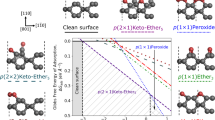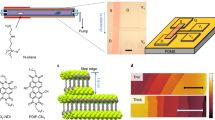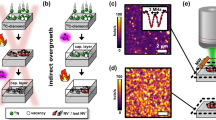Abstract
The electronic properties of many materials can be controlled by introducing appropriate impurities into the bulk crystal lattice in a process known as doping. In this way, diamond (a well-known insulator) can be transformed into a semiconductor1, and recent progress in thin-film diamond synthesis has sparked interest in the potential applications of semiconducting diamond2,3. However, the high dopant activation energies (in excess of 0.36 eV) and the limitation of donor incorporation to (111) growth facets only have hampered the development of diamond-based devices. Here we report a doping mechanism for diamond, using a method that does not require the introduction of foreign atoms into the diamond lattice. Instead, C60 molecules are evaporated onto the hydrogen-terminated diamond surface, where they induce a subsurface hole accumulation and a significant rise in two-dimensional conductivity. Our observations bear a resemblance to the so-called surface conductivity of diamond4,5,6,7,8 seen when hydrogenated diamond surfaces are exposed to air, and support an electrochemical model in which the reduction of hydrated protons in an aqueous surface layer gives rise to a hole accumulation layer6,7. We expect that transfer doping by C60 will open a broad vista of possible semiconductor applications for diamond.
This is a preview of subscription content, access via your institution
Access options
Subscribe to this journal
Receive 51 print issues and online access
$199.00 per year
only $3.90 per issue
Buy this article
- Purchase on Springer Link
- Instant access to full article PDF
Prices may be subject to local taxes which are calculated during checkout




Similar content being viewed by others
References
Nebel, C. E. & Ristein, J. (eds) Thin-Film Diamond I Monogr. Ser. Semiconductors and Semimetals Vol. 76, 145–259 (Elsevier, New York, 2003)
Nebel, C. E. & Ristein, J. (eds) Thin-Film Diamond II Monogr. Ser. Semiconductors and Semimetals Vol. 77, 97–338 (Elsevier, New York, 2004)
Isberg, J. et al. High carrier mobility on single-crystal plasma deposited diamond. Science 297, 1670–1672 (2002)
Denisenko, A. et al. Hypothesis on the conductivity mechanism in hydrogen terminated diamond. Diamond Relat. Mater. 9, 1138–1142 (2000)
Takeuchi, D., Yamanaka, S. & Okushi, H. Schottky junction properties of the high conductivity layer of diamond. Diamond Relat. Mater. 11, 355–358 (2002)
Ri, S. G. et al. Formation mechanism of p-type surface conductive layer on deposited diamond films. Jpn. J. Appl. Phys. 34, 5550–5555 (1995)
Maier, F., Riedel, M., Mantel, B., Ristein, J. & Ley, L. The origin of surface conductivity in diamond. Phys. Rev. Lett. 85, 3472–3475 (2000)
Kawarada, H. Hydrogen terminated diamond surfaces and interfaces. Surf. Sci. Rep. 26, 205–259 (1996)
Cui, J. B., Ristein, J. & Ley, L. The electron affinity of the bare and hydrogen covered single crystal diamond (111) surface. Phys. Rev. Lett. 81, 429–432 (1998)
Maier, F., Ristein, J. & Ley, L. Electron affinity of plasma-hydrogenated and chemically oxidized diamond (100) surfaces. Phys. Rev. B 64, 165411 (2001)
Yang, S. H., Petiette, C. L., Conceicao, J., Cheshnovsky, O. & Smalley, R. F. UPS of buckminsterfullerene and other large clusters of carbon. Chem. Phys. Lett. 139, 233–238 (1987)
Haddon, R. C. et al. C60 thin film transistors. Appl. Phys. Lett. 67, 121–123 (1995)
Hayashi, K. et al. Investigation of the effect of hydrogen on electrical and optical properties in chemical vapor deposited homoepitaxial diamond films. J. Appl. Phys. 81, 744–753 (1997)
Gunnarson, O. Superconductivity in fullerides. Rev. Mod. Phys. 69, 575–606 (1997)
Gluche, P., Aleksov, A., Vescan, A., Ebert, W. & Kohn, E. Diamond surface-channel FET structure with 200 V breakdown voltage. IEEE Electr. Dev. Lett. 18, 547549 (1997)
Riedel, M., Ristein, J. & Ley, L. Recovery of surface conductivity of H-terminated diamond after thermal annealing in vacuum. Phys. Rev. B 69, 125338 (2004)
Bandis, C. & Pate, B. B. Photoelectric emission from negative-electron-affinity diamond (111) surfaces: Exciton breakup versus conduction-band emission. Phys. Rev. B 52, 12056–12071 (1995)
Golden, M. S. et al. The electronic structure of fullerenes and fullerene compounds from high energy spectroscopy. J. Phys. Condens. Matter 7, 8219–8247 (1995)
Acknowledgements
We acknowledge A. Hirsch for the gift of C60 and fruitful discussion. Partial financial support by the Deutsche Forschungsgemeinschaft is also gratefully acknowledged.
Author information
Authors and Affiliations
Corresponding author
Ethics declarations
Competing interests
The authors declare that they have no competing financial interests.
Rights and permissions
About this article
Cite this article
Strobel, P., Riedel, M., Ristein, J. et al. Surface transfer doping of diamond. Nature 430, 439–441 (2004). https://doi.org/10.1038/nature02751
Received:
Accepted:
Issue Date:
DOI: https://doi.org/10.1038/nature02751
This article is cited by
-
Diamond electronics with high carrier mobilities
Nature Electronics (2022)
-
High-density/efficient surface active sites on modified separators to boost Li-S batteries via atomic Co3+-Se termination
Nano Research (2022)
-
Electrical doping in halide perovskites
Nature Reviews Materials (2021)
-
High-mobility p-channel wide-bandgap transistors based on hydrogen-terminated diamond/hexagonal boron nitride heterostructures
Nature Electronics (2021)
-
Spatial mapping of band bending in semiconductor devices using in situ quantum sensors
Nature Electronics (2018)
Comments
By submitting a comment you agree to abide by our Terms and Community Guidelines. If you find something abusive or that does not comply with our terms or guidelines please flag it as inappropriate.



